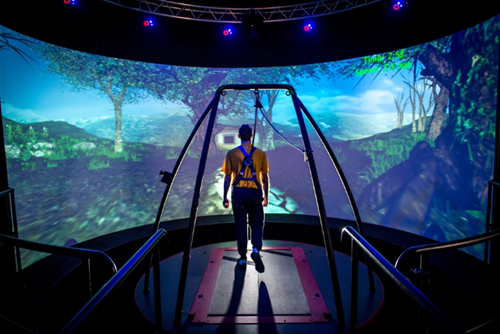
A NICoE Corpsman walks through a virtual reality scenario at the Computer Assisted Rehabilitation Environment (CAREN) Laboratory at National Intrepid Center of Excellence (NICoE) at Walter Reed National Military Medical Center (WRNMMC) in Bethesda, Md.
Overview
The Computer Assisted Rehabilitation Environment Laboratory (CAREN) incorporates virtual reality into the assessment and rehabilitation of injured service members (SMs). At the National Intrepid Center of Excellence (NICoE) on the campus of Walter Reed National Military Medical Center, the CAREN is used for both clinical and research purposes. The CAREN (Motekforce Link, Amsterdam, Netherlands) is a dynamic system with a motion platform that can translate and rotate in all directions. The NICoE platform contains an embedded, force plate-instrumented dual-belt treadmill, which moves in synchronization with virtual environments (VEs) projected onto a large, 180 degree curved screen. It operates in combination with a motion capture system (Vicon Motion Systems Ltd., Oxford, United Kingdom) which tracks the movement of reflective markers placed on each SM, allowing for interaction with and/or control over of each VE. There is also an overhead surround sound system and a 64-speaker array located behind the screen which may be utilized for some VEs. To ensure safety during utilization, SMs are tethered to the system’s safety stand through use of a full body harness.
Clinical
The system provides a safe, controlled environment for clinicians to address post-concussive symptoms in SMs with traumatic brain injury (TBI), including vestibular dysfunction, vision impairment, and dual-tasking and multi-sensory limitations. The clinical VEs utilized in the CAREN have been designed to be flexible, so that each can be made as easy or challenging as the SM requires or clinical provider requests. They include a variety of scenarios such as a city street, ski slope, and park. No combat scenarios are used.
SMs in the NICoE Intensive Outpatient Program (IOP) may be referred to the CAREN by their Physical or Occupational Therapist after clinical evaluations have been carried out by their interdisciplinary team. Outpatient referrals are also welcome, including those from other Military Treatment Facilities in the National Capital Area. Clinical sessions are typically 30-50 minutes in length and are overseen by the referring provider and NICoE CAREN Operator. VE outcomes and settings are recorded during the session and included in the SM’s electronic medical record in the Armed Forces Health Longitudinal Technology Application (AHLTA).
Research
Retrospective research seeks to quantify the large volume of clinical information collected at the NICoE to determine relationships between CAREN performance and SMs’ symptoms as well as symptom trajectories. Analyses also seek to illuminate the role of comorbid diagnoses, CAREN usage preferences (i.e., difficulty settings and VE sequences) by the clinical providers, and VE performance which may lead to refined outcome metrics and a standardized battery of assessments. Prospective research is focused on advancing our understanding of SMs with TBI and associated comorbidities, such as post-traumatic stress disorder (PTSD). Since the CAREN allows motor, visual, and audio tasks to be incorporated simultaneously, dual-tasking and multi-sensory integration are already being investigated. A novel therapeutic intervention to treat PTSD in SMs with a history of TBI is also being evaluated. Additionally, new technologies are being evaluated and compared against the CAREN to determine if the system can be pared-down and made portable for use in a variety of settings, to increase accessibility to providers and patients. Collaborative relationships have been established with the National Military Audiology and Speech Pathology Center, Hearing Center of Excellence, Uniformed Services University for the Health Sciences (USUHS), MIT Lincoln Laboratories, and Naval Health Research Center.
Published Research Involving the CAREN
- Overground and Virtual Reality Gait Speed are Associated with Atypical Symptom Reporting in Active Duty Service Members with a History of Mild to Moderate Traumatic Brain Injury
Journal of Head Trauma Rehabilitation, October 25, 2021
Sara M. Lippa, Kerry B. Rosen, Kathleen B. Delpy, Marcy M. Pape, Sarah E. Kruger
- Examining the Relationship between Conventional Outcomes and Immersive Balance Task Performance in Service Members with Mild Traumatic Brain Injury
Military Medicine, 2021; 186(5-6): 577-586
Kerry B. Rosen, Kathleen B. Delpy, Marcy M. Pape, Paula N. Kodosky, Sarah E. Kruger.
- The Effects of Blast-Related Neurotrauma on Aurally Aided Visual Search While Standing and Walking
Journal of Neurotrauma, 2019; 36(16): 2443-2453.
Douglas S. Brungart, Sarah E. Kruger, Tricia J. Kwiatkowski, Thomas A. Heil, Krista B. Highland, Julie Cohen, Melissa J. Kokx-Ryan, Jaclyn Schurman, Ashley Zaleski-King, Danielle Zion
- The Effect of Walking on Auditory Localization, Visual Discrimination, and Aurally Aided Visual Search
Human Factors, 2019; 61(6): 976-991
Douglas S. Brungart, Sarah E. Kruger, Tricia J. Kwiatkowski, Thomas A. Heil, Julie Cohen
- Expanding Clinical Assessment for Traumatic Brain Injury and Comorbid Post-Traumatic Stress Disorder: A Retrospective Analysis of Virtual Environment Tasks in the Computer Assisted Rehabilitation Environment (CAREN)
Military Medicine, 2017; 182, 3/4: 128-136
Marie M. Onakomaiya, Sarah E. Kruger, Krista B. Highland, Paula N. Kodosky, Marcy M. Pape, Michael J. Roy
- If you build it, they will come, but what will wounded warriors experience? Presence in the CAREN.
Annual Review of Cybertherapy and Telemedicine, 2015; 13: 23-27
Krista B. Highland, Sarah E. Kruger, Michael J. Roy
- Traumatic Brain Injury with Comorbid Posttraumatic Stress Disorder Affects Performance on Virtual Reality-Based Balance Tasks
IEEE Proceedings of the International Conference on Disability, Virtual Reality & Associated Technologies, September 4-6, 2018. Nottingham, United Kingdom.
Marie M. Onakomaiya, Marcy M. Pape, Tricia J. Kwiatkowski, Douglas S. Brungart, Sarah E. Kruger.